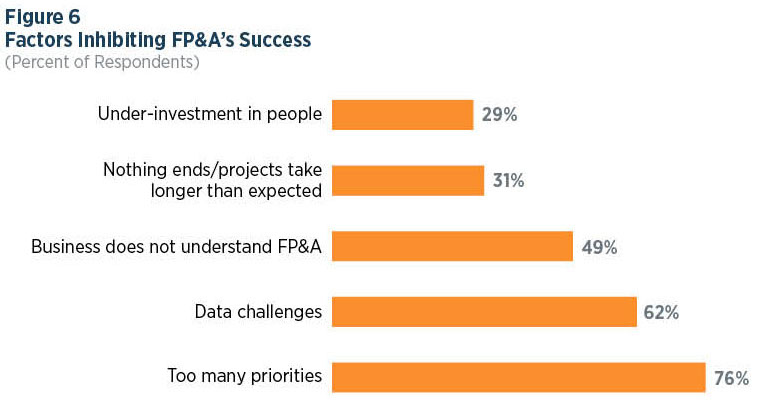Speed to Insights
The Value of Modern Data Tooling for Finance Organizations
David Shore | July 5, 2023Introduction:
In today's fast-paced business environment, finance organizations face increasing pressure to make timely and informed decisions. The ability to gain actionable insights quickly can be a game-changer, enabling organizations to adapt to market dynamics, identify growth opportunities, and stay ahead of the competition. But in the figure below from the 2022 AFP FP&A Survey, we see that solving data problems and freeing up time for FP&A would make them more successful. This is where the modern data solutions come into play, revolutionizing the way finance organizations harness the power of data. In this post, we explore the value of speed to insights for finance organizations and the value proposition of adopting aspects of modern data tooling solutions.

SOURCE: 2022 AFP FP&A Survey
The Need for Speed to Insights:
In the finance world, time is of the essence. Delays in accessing critical financial data and insights can have significant implications, leading to missed opportunities, increased risks, and reactive decision-making. Finance professionals need immediate access to real-time and accurate information to make data-driven decisions confidently.
Rapid Decision-Making:
Speed to insights empowers finance organizations to make agile and proactive decisions. With modern data tools, finance professionals can consolidate and analyze vast volumes of data from multiple sources quickly. This accelerated decision-making process enables organizations to respond swiftly to market changes, optimize financial performance, and seize competitive advantages.
Enhanced Operational Efficiency:
Traditional data handling processes can be time-consuming and inefficient, involving manual data extraction, manipulation, and analysis. Modern data tools can automate these processes, significantly reducing the time and effort required to transform raw data into actionable insights. Finance teams can allocate more time to strategic analysis, forecasting, and scenario planning, improving overall operational efficiency.
Real-Time Visibility:
Timely insights are critical for monitoring and managing financial performance. The modern data tools allow finance organizations to capture and process data in real-time, providing up-to-date visibility into key performance indicators (KPIs), financial metrics, and trends. Real-time monitoring enables proactive course correction, highlighting potential issues and opportunities as they arise, rather than after the fact.
The Value Proposition of Modern Data Tooling:
The modern data tools, consisting of advanced technologies and streamlined processes, offer compelling benefits for finance organizations seeking speed, accuracy, and scalability in their data analytics efforts.
Agile Data Integration:
The modern data tools integrate seamlessly with diverse data sources, including transactional systems, cloud-based applications, and external data feeds. By leveraging technologies such as cloud-based data warehouses and robust ETL (Extract, Transform, Load) tools, finance organizations can automate data integration, ensuring data accuracy and consistency. This agile integration enables faster insights by eliminating manual data collection and reconciliation efforts.
Scalability and Flexibility:
The most effective of these tools are designed to accommodate the ever-growing volume and complexity of financial data. Cloud-based data warehousing platforms, such as Amazon Redshift, Google BigQuery, or Snowflake, offer virtually limitless scalability, allowing finance organizations to store and process massive amounts of data without worrying about infrastructure constraints. Additionally, the modern data tools support flexible data models, empowering organizations to adapt to changing business needs and explore new avenues of analysis.
Advanced Analytics Capabilities:
Finance organizations can leverage modern data tools for advanced analytics capabilities to unlock deeper insights from their data. With tools like Python, R, or TensorFlow, finance professionals can apply sophisticated techniques such as machine learning, predictive modeling, and anomaly detection to uncover hidden patterns, forecast future performance, and identify outliers. These advanced analytics capabilities enable finance organizations to make data-driven decisions with greater precision and confidence.
Self-Service Visualization and Reporting:
The modern data tools include intuitive data visualization platforms, such as Tableau, Power BI, or Looker, which empower finance professionals to explore and present data in a user-friendly manner. Self-service dashboards and reports enable users to gain instant insights, create interactive visualizations, and share findings across the organization. This self-service approach reduces reliance on IT and analytics teams and expedites the generation of actionable insights.
Components of Speed to Insights:
It’s important to understand how we actually think about speed to insights. Just the phrase makes sense, you have data and want results, faster. But inherently we have something to measure here. Breaking down the data flow from raw data to actionable insights, we can actually start to measure individual components of this “speed”.
Time-to-Ingest: How quickly can new data sources be ingested?
Time-to-Transform: How long does it take to go from raw data to transformed, usable data models?
Time-to-Query: How long does it take to query the data to produce the desired results?
Time-to-Share: How long does it take to create a sharable result?
Time-to-Solve-Issues: How long does it take to (1) identify an issue in the entire process above and (2) how long does it take to resolve it.
Implementing modern data tooling enables focus on these individual components, making the entire process more approachable, and iterating on your analytics stack to increase the end-goal speed-to-insights.
Conclusion:
Speed to insights is no longer a luxury; it is a necessity for finance organizations striving to thrive in today's competitive landscape. By embracing modern data tooling, finance organizations can unlock the true value of their data, accelerating decision-making, enhancing operational efficiency, and gaining a competitive edge. With the ability to integrate, analyze, and visualize data rapidly, finance professionals can harness the power of data to drive strategic initiatives, optimize financial performance, and chart a path towards sustainable growth in the ever-evolving business environment.